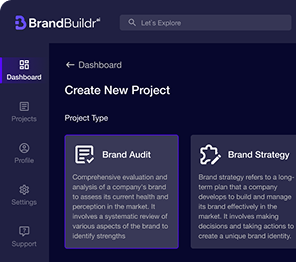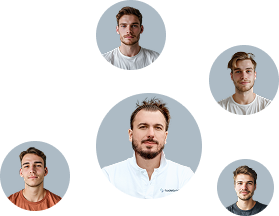The financial services sector has been undergoing significant changes, driven by rapid technological advancements. Digital transformation, a process that involves leveraging digital technologies to create new — or modify existing — business processes, culture, and customer experiences, is fundamentally reshaping the financial industry. For traditional financial institutions like banks, insurance companies, and credit unions, digital transformation has presented both challenges and opportunities.
This article explores the impact of digital transformation on traditional financial institutions, highlighting the opportunities for growth, the risks of falling behind, and strategies for successful implementation.
%20(1).avif)
1. Shifting Customer Expectations
The Demand for Convenience and Speed
Digital transformation has elevated customer expectations across all sectors, particularly in financial services. Today’s customers demand seamless, fast, and personalized services. With the rise of fintech companies offering digital-first solutions, traditional financial institutions are being forced to rethink how they engage with their customers. Consumers now expect mobile banking, instant payments, and personalized financial products catering to their needs.
For traditional banks, meeting these expectations requires more than just digitizing their services. It involves rethinking the entire customer journey and ensuring a consistent, high-quality experience across all touchpoints—whether online or offline.
Personalization and Customer-Centric Models
Digital transformation enables financial institutions to gather and analyze vast amounts of data on customer behavior and preferences. With AI and machine learning, banks can offer highly personalized services and products, from customized loan offers to tailored financial advice. This level of personalization is key to retaining existing customers and attracting new ones, as modern consumers value businesses that understand and cater to their unique needs.

2. Enhanced Operational Efficiency
Automation and AI Integration
One of the most significant benefits of digital transformation for traditional financial institutions is the potential for increased operational efficiency. Automation tools powered by artificial intelligence (AI) and machine learning (ML) can handle routine tasks, such as loan approvals, compliance checks, and customer service queries, freeing up human workers for more complex responsibilities.
By automating back-office processes, banks can reduce costs, eliminate human error, and speed up operations. For instance, robotic process automation (RPA) can handle tasks like data entry and account reconciliation much faster and more accurately than a human could, while AI chatbots can handle customer inquiries 24/7, improving customer service and satisfaction.
Streamlined Processes
Digital tools also allow for the simplification of complex processes. Traditional institutions often have legacy systems that are slow and cumbersome. With digital transformation, they can replace outdated systems with modern, cloud-based solutions that integrate various functions—from customer service to regulatory compliance—into a single platform. This not only speeds up processes but also makes them more transparent and accessible, both for employees and customers.
3. The Rise of Fintech Competitors
Disruption of Traditional Models
The rise of fintech companies has been one of the most disruptive forces in the financial industry. These tech-driven companies offer financial services through innovative digital platforms, often at a lower cost and with better customer experiences compared to traditional institutions. For example, companies like PayPal, Square, and Robinhood have redefined payment processing, investing, and money transfers, forcing traditional banks to catch up.
Traditional financial institutions are now competing with these nimble, tech-savvy companies. Fintech firms often have the advantage of being able to build their systems from scratch without having to deal with the challenges of legacy infrastructure. As a result, they can offer faster, more flexible, and user-friendly services, putting pressure on traditional banks to modernize their offerings.
Collaboration Between Fintech and Traditional Institutions
Rather than competing directly with fintech companies, some traditional financial institutions are choosing to collaborate with them. These partnerships allow banks to leverage fintech’s technological expertise while providing fintech companies with access to a broader customer base and a trusted brand. For example, banks can integrate fintech solutions into their existing platforms, offering customers innovative services like peer-to-peer lending, robo-advisors, and mobile wallets.
These partnerships are mutually beneficial and demonstrate how traditional financial institutions can adapt to the changing landscape while staying competitive.

4. Regulatory and Security Challenges
Navigating Regulatory Complexity
As financial institutions undergo digital transformation, they must also navigate a complex regulatory environment. Financial services are among the most heavily regulated industries, and digital transformation introduces new regulatory challenges. Institutions must ensure that their digital platforms comply with regulations related to data privacy, anti-money laundering (AML), and know-your-customer (KYC) requirements.
Additionally, the increasing use of AI and automated decision-making processes raises ethical and legal questions around transparency and accountability. Regulators are increasingly scrutinizing how AI algorithms are used in credit scoring, loan approvals, and fraud detection, which requires institutions to maintain transparency and fairness in their AI models.
Cybersecurity Threats
With the digitization of financial services comes an increased risk of cyberattacks. Cybersecurity is a top priority for financial institutions as they hold vast amounts of sensitive data, making them prime targets for hackers. Data breaches, ransomware attacks, and phishing schemes can cause significant financial losses and damage to a bank’s reputation.
To mitigate these risks, traditional financial institutions must invest in robust cybersecurity measures, including encryption, multi-factor authentication, and regular security audits. Furthermore, as new technologies such as blockchain gain traction, banks may look to these solutions to enhance security, transparency, and trust in digital transactions.

5. Blockchain and Cryptocurrencies
Adoption of Blockchain Technology
Blockchain technology is reshaping the future of finance. While initially associated with cryptocurrencies like Bitcoin, blockchain has broader applications in areas such as cross-border payments, smart contracts, and identity verification. By enabling secure, transparent, and tamper-proof transactions, blockchain has the potential to reduce the costs and complexity of financial processes.
Traditional financial institutions are beginning to explore the use of blockchain to streamline back-office operations, increase transparency, and improve the speed and security of transactions. For example, blockchain can facilitate instant, low-cost international transfers, eliminating the need for intermediaries.
Cryptocurrencies and Central Bank Digital Currencies (CBDCs)
The rise of cryptocurrencies poses both challenges and opportunities for traditional financial institutions. While some banks view cryptocurrencies as a threat to their business models, others are exploring ways to integrate them into their offerings. For example, some banks have begun to offer cryptocurrency custody services or invest in blockchain-based payment networks.
Additionally, central banks around the world are exploring the development of Central Bank Digital Currencies (CBDCs). CBDCs are digital versions of national currencies that could provide a stable, government-backed alternative to decentralized cryptocurrencies like Bitcoin. As CBDCs become more widely adopted, traditional financial institutions will need to adapt to this new form of currency and incorporate it into their existing systems.

6. The Future of Branch Banking
The Decline of Physical Branches
Digital transformation has also accelerated the decline of physical bank branches. With the rise of mobile banking apps and online services, customers no longer need to visit a branch to perform routine tasks like depositing checks, transferring money, or applying for loans. As a result, many banks are closing branches or repurposing them as smaller, technology-driven hubs.
While branches will likely continue to exist in some form, their role will evolve. In the future, branches may focus more on providing personalized financial advice or handling complex transactions that require human interaction, while routine services are handled digitally.
The Role of Hybrid Banking Models
As digital transformation continues, we may see the rise of hybrid banking models that combine the best of both worlds — offering the convenience of digital services with the personal touch of in-person interactions. For example, banks may offer video conferencing with financial advisors through their mobile apps or provide advanced ATMs that offer more services than traditional machines.
Digital transformation is not just a trend but a necessity for traditional financial institutions to remain competitive, meet rising customer expectations, and harness the potential of new technologies like AI and blockchain.
Conclusion
Digital transformation is having a profound impact on traditional financial institutions, forcing them to adapt to a rapidly changing landscape. From shifting customer expectations to the rise of fintech competitors, the challenges are numerous. However, the opportunities for growth and innovation are equally significant.
By embracing digital transformation, traditional financial institutions can improve operational efficiency, enhance customer experiences, and stay competitive in an increasingly digital world. Those that fail to adapt risk being left behind, but for those willing to innovate, the future of finance is full of exciting possibilities.
Heading 1
Heading 2
Heading 3
Heading 4
Heading 5
Heading 6
Lorem ipsum dolor sit amet, consectetur adipiscing elit, sed do eiusmod tempor incididunt ut labore et dolore magna aliqua. Ut enim ad minim veniam, quis nostrud exercitation ullamco laboris nisi ut aliquip ex ea commodo consequat. Duis aute irure dolor in reprehenderit in voluptate velit esse cillum dolore eu fugiat nulla pariatur.
Block quote
Ordered list
- Item 1
- Item 2
- Item 3
Unordered list
- Item A
- Item B
- Item C
Bold text
Emphasis
Superscript
Subscript





















.avif)



.avif)

.avif)


